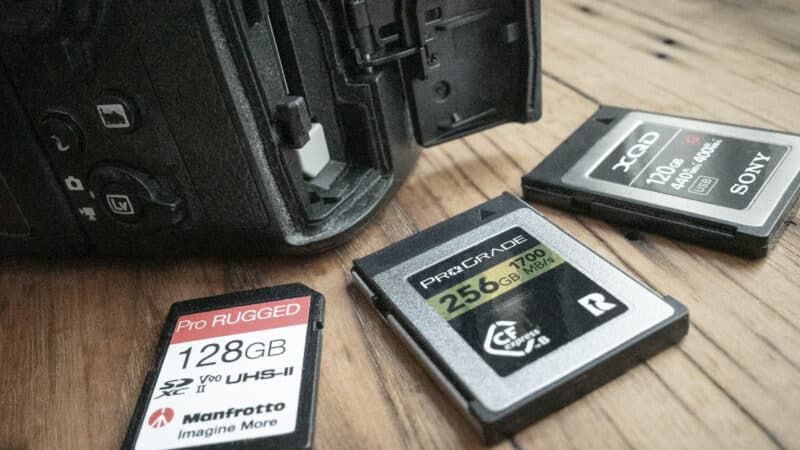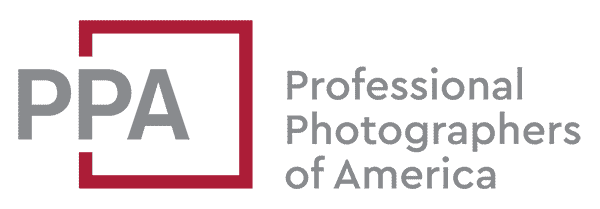Nikon Z6 vs Z6 II
This post refers specifically to the Nikon Z6.
Nikon has since released an upgraded version, the Z6 II, and it has different memory card requirements. I have a newer post with Nikon Z6 II memory card recommendations.
There is a little trick to what kind of memory card the Nikon Z6 takes. That’s because of a tweak that Nikon made with a firmware update after the camera was released.
When the Nikon Z6 was released in mid-2018, it was compatible only with the XQD cards. But in December 2019, Nikon released firmware v.2.20 for the Z6. It makes the XQD memory card slot compatible with CFexpress Type B cards. (Nikon has since released several more firmware updates for the Z6; you can find them here.)1
So what’s the advantage of CFexpress Type B? They’re both the same physical size and shape and pin layout as each other (i.e., they share the same form factor). But the upgrade is not just about broader compatibility.
CFexpress Type B is basically a newer evolution of XQD. And in practical terms, it’s both much faster, and the cards are also becoming more widely available, leading to more choice and lower prices. At the time of writing, most of the currently available XQD cards are rated for speeds of around 440 MB/s read and 400 MB/s write. Most of the currently available CFexpress B cards are rated for around 1700 MB/s read and at least 1200 MB/s write (or faster). CFexpress 2.0 cards are theoretically capable of up to 4GB/sec data transfer.2
Table of Contents
Nikon Z6 Memory Card Recommendations in Detail
Number of Memory Card Slots. The Nikon Z6 has a single memory card slot: XQD / CFexpress B.
Approved Memory Cards. As usual, Nikon is quite vague when it comes to which memory cards are compatible. The initial v.2.20 firmware release added compatibility with Sony CFexpress B cards; a subsequent release (v.3.00) explicitly added support for ProGrade Digital and Lexar CFexpress B cards.
In the manual, it only says this:
The camera can be used with XQD and CFexpress (Type B) memory cards. Cards with write speeds of 45 MB/s (300x) or better are recommended for movie recording; slower speeds may interrupt recording or playback or result in playback that is jerky and uneven. For information on compatibility and operation, contact the manufacturer.
CFexpress B. With a firmware update in December 2019 (C:Ver.2.20), Nikon made the XQD slot also able to accept CFexpress B cards.3
It’s important to note the “B” here. Confusingly, there are currently three types of CFexpress cards, and they’re all different physical sizes (aka form factors), and they’re not interchangeable. Put a different way, a CFexpress A card won’t work–or even fit–in a CFexpress B slot.4
CFexpress A is the same physical size as SD cards, and that’s the type used in some cameras, such as the Sony A1 mirrorless camera.
What you want for the Nikon Z6 is the CFexpress B. You’ll sometimes see it written as CFexpress (Type B). CFexpress B cards are the same size and have the same contacts as an XQD card, which is what makes this improvement possible.
If you try using a CFexpress A or CFexpress C card in the Z6, it won’t work.
B&H Photo has an excellent selection of CFexpress B cards from manufacturers like Delkin, SanDisk, Lexar, Sony, ProGrade Digital, and Angelbird. You can find them here.
- Records 8K, 6K & 4K Video at High Frame Rates & Bitrates
- RAW Continuous-Burst Ready
- Read speeds of up to 1700MB/s and 1400MB/s write speeds** offer low latency during high-speed recording...
- Enables smooth, RAW 4K video(1) | (1)4K video (4069x2160p) support may vary based on host device, file...
- LIGHTING FAST WRITE SPEED – Capture 4K, 6K and beyond with our Write Speed of up to 1500MB/s. Great for...
- XQD USERS UPGRADE TO THE LATEST TECHNOLOGY: Backward compatible with XQD devices with firmware update...
XQD. XQD is an older format, and while these cards are quick, they’re not nearly as quick as CFexpress B cards. And since the price of CFexpress B cards has come down considerably, there’s not much practical advantage in choosing XQD over CFexpress B unless other parts of your workflow are geared towards XQD.
B&H has a good selection of XQD cards. You can find them here.
- Speed: The cards feature a maximum read speed of 440MB/s and maximum write speed of 400MB/s
- Compatibility: The Nikon 64GB XQD Memory Card is a high speed XQD format memory card for use with high...
Things Worth Knowing
Camera not recognizing CFexpress B card. If your Z6 isn’t recognizing your CFexpress B card, the most likely cause is that the camera’s firmware needs to be updated. Firmware version C:Ver.2.20 was released in December 2019. And, unlike phones and some other devices, the Z6 does not update its software automatically.
You can download the firmware (C:Ver.2.20 or newer) and find Nikon’s installation instructions here.
Memory Card Readers. Don’t forget that you’ll need a compatible card reader to download the images to your computer. A CFexpress B card will physically fit in an XQD card reader, but just as with the camera, the hardware needs to be compatible. There are some cross-compatible readers available, like this one, but you can’t assume your old XQD reader will work with CFexpress B cards.
I use Prograde Digital Readers these days and have had excellent results. They’re high-end readers, but I’ve found them to be very fast and reliable. They make an XQD/CFexpress B reader with a Thunderbolt 3 connection and CFexpress B readers, but not dedicated XQD-only readers.
Sony also makes one that works with both XQD and CFexpress B cards.
- DO MORE OF WHAT YOU LOVE: Because the ProGrade Digital Thunderbolt 3 Single-Slot CFexpress Type-B & XQD...
- DESIGNED FOR LIFE ON THE ROAD: Wherever you go, your included adhesive metal plate attaches the magnetic...
- For XQD and CFexpress Type B cards
- USB 3.1 Gen 2 Interface
You can also find cheaper options from third-party manufacturers.
You don’t run into the same issues with SD readers–they’re very widely available. That said, speed and performance vary widely. If you’re using a UHS-II card, you get better performance from a UHS-II-compatible memory card reader. Prograde Digital makes some good ones, including a dual-slot card that has both CFexpress B and UHS-II SDXC slots (this is the one I use).
- DO MORE OF WHAT YOU LOVE: Because the ProGrade Digital™ USB 3.2 Gen 2 CFexpress™...
- DESIGNED FOR LIFE ON THE ROAD: Wherever you go, your included adhesive metal plate attaches the...
When you go to format the memory cards using the camera’s menu system, it will still refer to the XQD card even after the firmware upgrade and regardless of whether you’re using an XQD or CFexpress B card.
There’s also a CFast memory card format. That’s different again. It’s an older format form factor that was an evolution from CompactFlash (CF). It’s not compatible with CFexpress.
Nikon Z6 Memory Card FAQs
What type of memory card does the Nikon Z6 use?
The Nikon Z6 mirrorless camera is compatible with XQD and CFexpress B memory cards. Firmware v.2.20 or later is required for the CFexpress B compatibility.
How many memory cards does the Nikon Z6 take?
The Nikon Z6 has a single XQD/CFexpress B memory card slot.
More to Check Out
If you enjoyed this, these might also be of interest:
- The initial v.2.20 firmware release included support for Sony CFexpress B cards. It was followed up with v.3.00, which among several other enhancements also added support for ProGrade and Lexar CFexpress B cards. [↩]
- Another issue is that XQD is a Sony trademark, which imposes complications (and potentially expense) for other manufacturers. [↩]
- A year later, in December 2020, Nikon had issued firmware earlier for the Nikon D850 that had added CFexpress B support to that camera. [↩]
- Even more confusingly, there are also versions within each of these form factors. Those affect compatibility but aren’t related to the physical size of the cards. [↩]
Images and product information from Amazon PA-API were last updated on 2024-05-17 at 15:34. Product prices and availability are accurate as of the date/time indicated and are subject to change. Any price and availability information displayed on Amazon Site at the time of purchase will apply to the purchase of this product.











